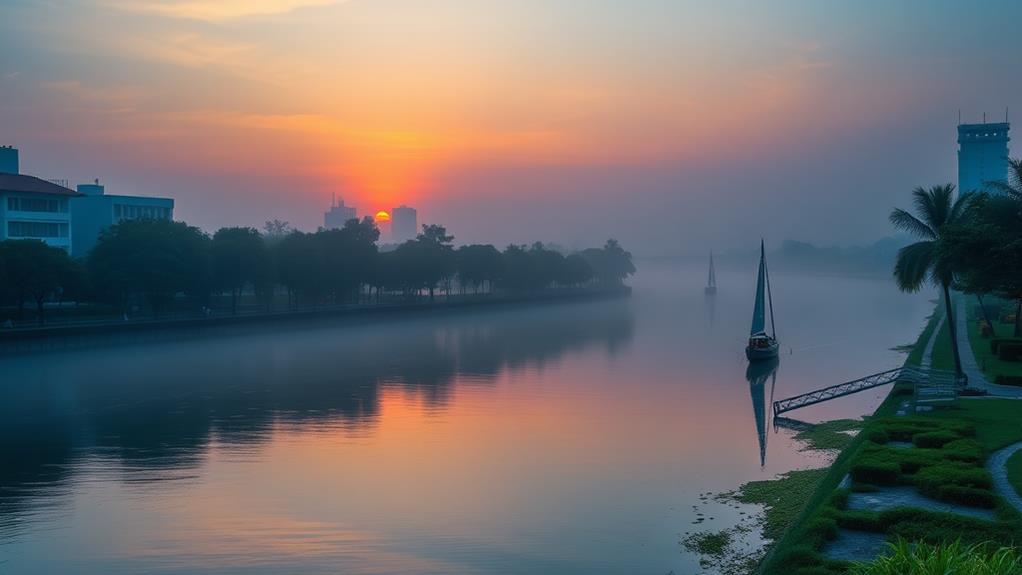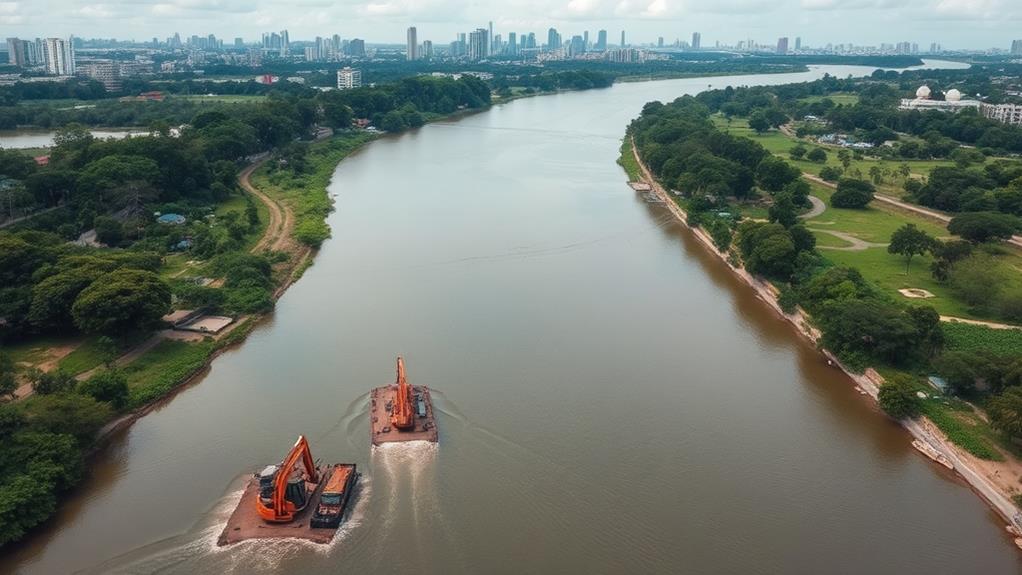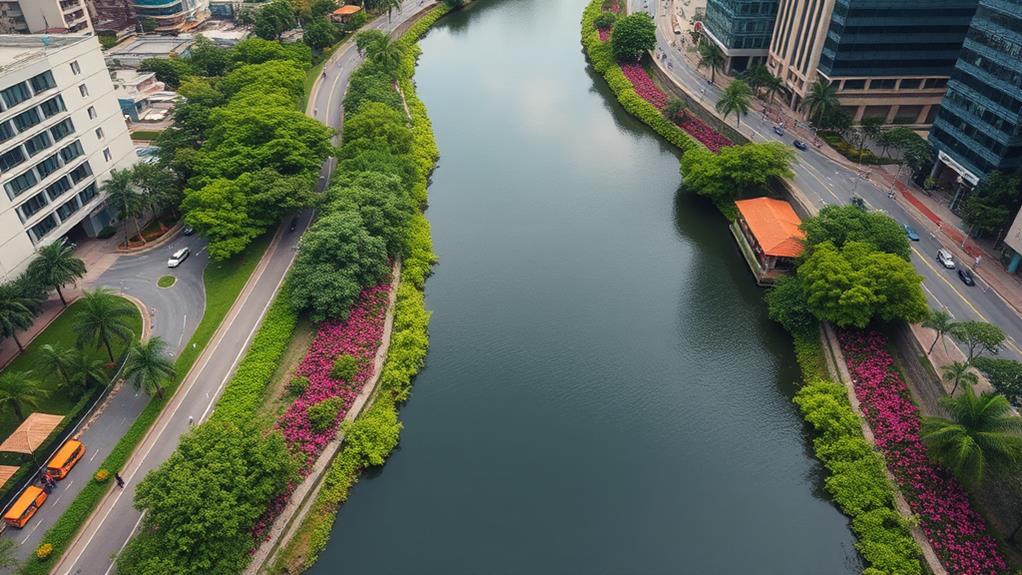The Pasig River, once declared biologically dead in the 1990s due to severe pollution, is undergoing a transformative revival. Over 1.3 million tons of waste have been removed so far. This monumental effort is the result of coordinated initiatives, including the establishment of an inter-agency council and a P2 billion commitment from San Miguel Corporation for a comprehensive river cleanup program.
The rehabilitation of the Pasig River faces complex challenges, including the need to address pollution, improve water quality, and revitalize the surrounding ecosystem.
However, these efforts also present opportunities for transformation. A restored Pasig River has the potential to become a thriving hub of activity, enhancing the quality of life for nearby communities and supporting local economic growth.
As the revival efforts continue, it is essential to address the underlying causes of pollution and develop sustainable solutions to ensure the long-term health of the river.
By understanding the challenges and opportunities surrounding the Pasig River's rehabilitation, we can work towards a brighter future for this historic waterway.
Reviving the River's Glory Days

The Pasig River has a rich history as a vital transportation route and source of livelihood, but it began to decline in the 1930s.
The river's rehabilitation is now underway, focusing on improving water quality and restoring marine life.
The Inter-Agency Council for Pasig River Urban Development, established in 2023, is leading the rehabilitation efforts through a collaborative approach.
This coordinated effort involves both government agencies and private sector partners, like San Miguel Corporation, which has committed P2 billion to a river cleanup program.
So far, this initiative has removed over 1.3 million tons of waste from the river.
Urban development projects are also underway to restore the Pasig River to its former glory.
A 500-meter showcase area has been inaugurated, and plans are in place for a 50 km promenade along both riverbanks.
These efforts aim to make the Pasig River a thriving hub of activity once again.
Pollution's Devastating Impact
The rehabilitation of the Pasig River is crucial, but it's essential to acknowledge the devastating impact of pollution on the river. The Pasig River was declared biologically dead in the 1990s due to severe pollution, rendering it incapable of sustaining marine life and contributing to its status as the most polluted body of water globally.
The pollution milestones that led to this point are:
The 1930s saw a decline in fish migration, disrupting the ecosystem. This decline was a result of the increasing pollution in the river.
By the 1950s, the decrease in bathing activities raised public health concerns. The poor water quality made it unsafe for people to bathe in the river.
The 1960s saw a prohibition on washing clothes in the river due to water quality deterioration. This prohibition was a result of the increasing pollution in the river.
The 1970s were marked by foul odors and murky waters, highlighting environmental issues and public health risks. The pollution in the river had severe consequences for both the environment and human health.
The 1990s saw the river being declared biologically dead, resulting in the loss of marine life and its contribution to global pollution. This declaration was a result of the severe pollution in the river.
The Pasig River has become a significant contributor of plastic waste to the oceans, exacerbating environmental issues both locally and globally.
The presence of illegal settlements along the riverbanks has further complicated efforts to combat pollution. It's crucial to address these challenges as part of the rehabilitation efforts to improve water quality and restore the river's former glory.
Rehabilitation Efforts and Challenges

The Pasig River rehabilitation has been an ongoing effort with various initiatives and challenges.
In 1999, the Danish International Development Agency (DANIDA) backed a program focusing on environmental management and urban renewal with a $200 million loan. This initiative demonstrated the importance of investing in rehabilitation efforts.
Gina Lopez played a crucial role in the rehabilitation process.
As the Pasig River Rehabilitation Chief in 2010, Lopez led initiatives that earned recognition, including the Asia RiverPrize in 2018 for community housing and environmental responsibility. Her leadership showcased the impact of dedicated efforts on the river's condition.
However, the rehabilitation process faced setbacks.
The Pasig River Rehabilitation Commission was abolished in 2019, with the Duterte administration declaring the river uncleanable. This highlights the need for ongoing and effective rehabilitation strategies to ensure progress isn't reversed.
Recent efforts have been made to revitalize the rehabilitation process.
In 2023, President Marcos issued Executive Order No. 35, forming an Inter-Agency Council to improve water quality and restore marine life. This move demonstrates the government's renewed commitment to addressing the river's condition.
Private sector initiatives have also contributed to the rehabilitation efforts.
San Miguel Corporation's 2021 cleanup program removed 1.3 million tons of waste, illustrating the impact of collective efforts on the river's cleanliness.
Despite these efforts, challenges persist.
Illegal settlements and intermittent ferry services remain significant obstacles to the rehabilitation process. Addressing these challenges is crucial to achieving long-term success.
Community Involvement and Concerns
Community involvement is crucial to the Pasig River's rehabilitation. Local government units are leading the effort, with notable successes such as the 16,000 volunteers who participated in cleanup drives in March 2019.
The rehabilitation process faces challenges, particularly in relocating residents of shanty towns along the river. Residents' rights must be protected, and sustainable living conditions provided.
Historically, relocation efforts have been met with resistance, as seen in the violent protests in Barangay Pineda in September 2000.
To ensure the success of the Pasig River rehabilitation, several key concerns must be addressed:
Relocation efforts require protecting the rights of the urban poor and providing sustainable living conditions. This involves providing alternative housing and livelihood opportunities to those displaced.
Community engagement is essential, and initiatives like urban farming and community gardens promote environmental stewardship and encourage local involvement. These projects empower communities to take ownership of the rehabilitation process.
Public support is vital, and the rehabilitation process hinges on your support and engagement. The positive response to projects like the Dolomite Beach initiative in Manila Bay demonstrates the impact of public involvement.
Urban Development and Transportation

Urban Development and Transportation Revitalize the Pasig River
Urban development and transportation are key factors in the revival of the Pasig River. The Pasig River Ferry Service, reintroduced in 2007, offered the longest ferry route in the Philippines. Although it ceased operations in 2011 due to financial losses, it was revived by the MMDA in 2014.
A P18-billion urban development project inaugurated the Pasig River Esplanade on January 17, 2024, which is designed to extend 25 kilometers along each riverbank, promoting urban renewal and recreational spaces. This project aims to enhance public access and community engagement by constructing a 50 km promenade along both banks of the Pasig River.
Future transportation initiatives include dredging the river for better navigability and establishing integrated transport networks. These networks will connect rail and expressways to the river, enhancing accessibility and tourism.
The strategic development of waterfront economic zones will boost local businesses and tourism by creating vibrant spaces that merge urban life with the river environment.
Future Prospects and Economic Potential
Looking ahead, the Pasig River rehabilitation project is expected to unlock significant economic potential and transform the surrounding area into a thriving hub of activity. The planned 50 km promenade along both riverbanks, estimated to cost ₱18 billion, will undoubtedly enhance economic activity and tourism potential in the area.
Three key aspects will drive growth and development:
Local business development will receive a boost as the introduction of more ferry boats and stations improves accessibility, encouraging local businesses to flourish along the riverbanks.
For instance, easier access to the riverbanks will attract more customers to local shops and restaurants.
Sustainable practices will be promoted through the integration of urban gardens and green technology, such as solar lights and rain harvesting facilities, which will enhance community well-being.
This won't only reduce the area's carbon footprint but also create a healthier environment for residents and visitors.
Collaboration between local government units and communities is crucial for sustaining cleanup efforts, which will further boost economic development and tourism along the revitalized Pasig River.
This collaboration will ensure that the area remains clean and attractive, thereby promoting economic growth and tourism.
As the project takes shape, a surge in maritime transport, local business development, and tourism is expected, ultimately transforming the Pasig River into a vibrant hub of activity that benefits the community and promotes sustainable practices.
Ongoing Conservation and Sustainability

Fifteen government agencies are collaborating to restore the Pasig River through an inter-agency council established by Executive Order No. 35. Led by the Department of Environment and Natural Resources, this council oversees initiatives focused on conservation and sustainability.
Vetiver grass is being planted along riverbanks to prevent erosion, while Coco Coir and beneficial bacteria are being utilized to decompose waste effectively, contributing to improved water quality and ecosystem restoration.
Community involvement is crucial in these efforts, as local government units engage residents in cleaning drives and sustainable practices, fostering a sense of ownership and responsibility towards the river.
The Pasig River project incorporates green technology, such as solar lights and rain harvesting facilities, along with urban gardens to promote sustainability and enhance community well-being.
Future initiatives focus on creating a waterfront economic zone, stimulating local business development and tourism while aligning economic growth with environmental conservation efforts.
Frequently Asked Questions
Can Pasig River Be Revived?
Yes, a dying waterway can be revived. Reviving a polluted river requires a multifaceted approach that involves effective restoration strategies, community involvement, and government initiatives.
Improving water quality is crucial, which can be achieved by reducing pollution from industrial and agricultural activities, as well as promoting sustainable practices such as recycling and proper waste management.
Preserving historical areas along the riverbank also plays a vital role in maintaining the river's ecological impact and enhancing urban development.
Public awareness and education are essential in maintaining a river's health. Educational programs can inform the public about the importance of preserving the river and the simple actions they can take to contribute to its revival.
For example, properly disposing of trash and reducing water usage can significantly reduce pollution. Additionally, community involvement in cleanup efforts and restoration projects can foster a sense of ownership and responsibility among residents.
With collective effort, a once-dead river can thrive again. By implementing these strategies, a polluted river can be restored to its former glory, providing a healthier environment for both humans and wildlife.
What Is the Historical Significance of Pasig River?
Pasig River is a treasure trove of cultural heritage. As a vital trade route, it linked Manila to Laguna de Bay, fueling economic growth during the colonial period. Furthermore, the river played a crucial role in the transportation of goods and people, shaping the landscape and economy of the surrounding cities. Its geography in Philippine history cannot be overstated, as it has been a witness to the country’s development and the struggles of its people. Understanding the historical significance of Pasig River provides valuable insights into the cultural and economic dynamics of the Philippines.
The river served as a commercial highway, facilitating the exchange of goods between the two regions.
The riverbanks played a significant role in shaping Manila's urban development. Bustling markets and residential areas sprouted along the riverbanks, making it a hub of activity.
However, its environmental impact led to decline, and the river's importance waned over time.
Today, conservation efforts focus on reviving its cultural significance. Recognizing its importance as a waterway transportation hub, efforts are being made to promote community engagement to preserve its rich history.
Why Was Pasig River Declared Biologically Dead in the 1990s?
The Pasig River was declared biologically dead in the 1990s due to severe water pollution. This pollution was mainly caused by poor waste management practices. As urban development boomed, the river became a dumping ground for waste, leading to extremely high coliform content.
For example, the river's coliform level reached 330 million most probable number (MPN) per 100 milliliters, way above the safe level of 1,000 MPN/100mL.
Lack of community involvement and inadequate government initiatives contributed to the river's decline. The neglect of environmental conservation efforts further exacerbated the problem.
For instance, the government's failure to implement and enforce laws regulating waste disposal led to the unchecked dumping of waste into the river.
This ecological disaster highlights the need for public awareness and a historical context to understand the importance of ecological restoration.
Is Pasig River Still Polluted Today?
The Pasig River remains polluted today. Despite ongoing cleanup efforts, the river's water quality stays poor due to persistent pollution sources.
Government initiatives and community involvement are crucial to address this issue.
The river's water quality poses significant health risks. The murky waters and foul odors threaten aquatic life and the environment.
Daily water monitoring is essential to mitigate the river's environmental impact.